Integrated Optical Filters with Hyperbolic Metamaterials
Abstract
1. Introduction
2. Materials and Methods
2.1. Description of the Integrated System
2.2. Effective Medium Theory
2.3. Transfer Matrix Method
2.4. Light Propagation in a 3D Integrated Device
3. Results
4. Discussion
Author Contributions
Funding
Institutional Review Board Statement
Informed Consent Statement
Data Availability Statement
Acknowledgments
Conflicts of Interest
Abbreviations
| TM | Transverse Magnetic |
| TE | Transverse Electric |
| Wavelength spectral bandwidth | |
| FWHM | Full width at half maximum |
References
- Kogelnik, H. An Introduction to Integrated Optics. IEEE Trans. Microw. Theory Tech. 1975, 23, 2–16. [Google Scholar] [CrossRef]
- Suhara, T.; Nishihara, H. Integrated optics components and devices using periodic structures. IEEE J. Quantum Electron. 1986, 22, 845–867. [Google Scholar] [CrossRef]
- Okamoto, K. Recent progress of integrated optics planar lightwave circuits. Opt. Quantum Electron. 1999, 31, 107–129. [Google Scholar] [CrossRef]
- Ma, H.; Jen, A.Y.; Dalton, L. Polymer-Based Optical Waveguides: Materials, Processing, and Devices. Adv. Mater. 2002, 14, 1339–1365. [Google Scholar] [CrossRef]
- Broquin, J.E. Glass integrated optics: State of the art and position toward other technologies. In Proceedings of the Integrated Optics: Devices, Materials, and Technologies XI, San Jose, CA, USA, 20–25 January 2007; Sidorin, Y., Waechter, C.A., Eds.; International Society for Optics and Photonics, SPIE: Bellingham, WA, USA, 2007; Volume 6475, p. 647507. [Google Scholar] [CrossRef]
- Sohler, W.; Hu, H.; Ricken, R.; Quiring, V.; Vannahme, C.; Herrmann, H.; Büchter, D.; Reza, S.; Grundkötter, W.; Orlov, S.; et al. Integrated Optical Devices in Lithium Niobate. Opt. Photon. News 2008, 19, 24–31. [Google Scholar] [CrossRef]
- Tong, X.C. Advanced Materials for Integrated Optical Waveguides; Springer: Cham, Switzerland, 2013; p. 552. [Google Scholar]
- Zheludev, N.I.; Kivshar, Y.S. From metamaterials to metadevices. Nat. Mater. 2012, 19, 917–924. [Google Scholar] [CrossRef]
- Urbas, A.M.; Jacob, Z.; Negro, L.D.; Engheta, N.; Boardman, A.D.; Egan, P.; Khanikaev, A.B.; Menon, V.; Ferrera, M.; Kinsey, N.; et al. Roadmap on optical metamaterials. J. Opt. 2016, 18, 093005. [Google Scholar] [CrossRef]
- Liang, Y.; Koshelev, K.; Zhang, F.; Lin, H.; Lin, S.; Wu, J.; Jia, B.; Kivshar, Y. Bound States in the Continuum in Anisotropic Plasmonic Metasurfaces. Nano Lett. 2020, 20, 6351–6356. [Google Scholar] [CrossRef]
- Rabus, D.G.; Sada, C. Integrated Ring Resonators, 2nd ed.; Springer: Cham, Switzerland, 2020; p. 360. [Google Scholar]
- Holmgaard, T.; Chen, Z.; Bozhevolnyi, S.I.; Markey, L.; Dereux, A. Dielectric-loaded plasmonic waveguide-ring resonators. Opt. Express 2009, 17, 2968–2975. [Google Scholar] [CrossRef]
- Pérez-Galacho, D.; Alonso-Ramos, C.; Mazeas, F.; Roux, X.L.; Oser, D.; Zhang, W.; Marris-Morini, D.; Labonté, L.; Tanzilli, S.; Cassan, É.; et al. Optical pump-rejection filter based on silicon sub-wavelength engineered photonic structures. Opt. Lett. 2017, 42, 1468–1471. [Google Scholar] [CrossRef]
- Čtyroký, J.; Wangüemert-Pérez, J.G.; Kwiecien, P.; Richter, I.; Litvik, J.; Schmid, J.H.; Íñigo Molina-Fernández, I.; Moñux, A.O.M.; Dado, M.; Cheben, P. Design of narrowband Bragg spectral filters in subwavelength grating metamaterial waveguides. Opt. Express 2018, 26, 179–194. [Google Scholar] [CrossRef]
- Quaranta, G.; Basset, G.; Martin, O.J.F.; Gallinet, B. Recent Advances in Resonant Waveguide Gratings. Laser Photonics Rev. 2018, 12, 1800017. [Google Scholar] [CrossRef]
- Matsko, A.; Ilchenko, V. Optical resonators with whispering-gallery modes-part I: Basics. IEEE J. Sel. Top. Quantum Electron. 2006, 12, 3–14. [Google Scholar] [CrossRef]
- Lu, H.; Liu, X.; Mao, D.; Wang, L.; Gong, Y. Tunable band-pass plasmonic waveguide filters with nanodisk resonators. Opt. Express 2010, 18, 17922–17927. [Google Scholar] [CrossRef]
- Khani, S.; Danaie, M.; Rezaei, P. Realization of single-mode plasmonic bandpass filters using improved nanodisk resonators. Opt. Commun. 2018, 420, 147–156. [Google Scholar] [CrossRef]
- Tao, J.; Huang, X.G.; Lin, X.; Zhang, Q.; Jin, X. A narrow-band subwavelength plasmonic waveguide filter with asymmetrical multiple-teeth-shaped structure. Opt. Express 2009, 17, 13989–13994. [Google Scholar] [CrossRef]
- López-Rayón, F.; Arroyo Carrasco, M.L.; Rodríguez-Beltrán, R.I.; Salas-Montiel, R.; Téllez-Limón, R. Plasmonic-Induced Transparencies in an Integrated Metaphotonic System. Nanomaterials 2022, 12, 1701. [Google Scholar] [CrossRef]
- Lin, X.S.; Huang, X.G. Tooth-shaped plasmonic waveguide filters with nanometeric sizes. Opt. Lett. 2008, 33, 2874–2876. [Google Scholar] [CrossRef]
- Neutens, P.; Lagae, L.; Borghs, G.; Dorpe, P.V. Plasmon filters and resonators in metal-insulator-metal waveguides. Opt. Express 2012, 20, 3408–3423. [Google Scholar] [CrossRef]
- Tan, D.T.H.; Ikeda, K.; Fainman, Y. Cladding-modulated Bragg gratings in silicon waveguides. Opt. Lett. 2009, 34, 1357–1359. [Google Scholar] [CrossRef]
- Yun, H.; Hammood, M.; Chrostowski, L.; Jaeger, N.A.F. Optical Add-drop Filters using Cladding-modulated Sub-wavelength Grating Contra-directional Couplers for Silicon-on-Insulator Platforms. In Proceedings of the 2019 IEEE 10th Annual Information Technology, Electronics and Mobile Communication Conference (IEMCON), Vancouver, BC, Canada, 17–19 October 2019; pp. 0926–0931. [Google Scholar] [CrossRef]
- Yen, T.H.; Shih, B.H.; Cheng, N.W.; Hung, Y.J. Linewidth-adjustable bandpass filter based on silicon cladding-modulated waveguide moiré Bragg gratings. In Proceedings of the Conference on Lasers and Electro-Optics, San Jose, CA, USA, 13–18 May 2018; p. JW2A.38. [Google Scholar] [CrossRef]
- Yen, T.H.; Wu, C.J.; Yu, C.J.; Hung, Y.J. Silicon photonics multi-channel Bragg reflectors based on narrowband cladding-modulated gratings. In Proceedings of the 2017 Conference on Lasers and Electro-Optics (CLEO), San Jose, CA, USA, 14–19 May 2017; pp. 1–2. [Google Scholar]
- Jin, Y.; Fernez, N.; Pennec, Y.; Bonello, B.; Moiseyenko, R.P.; Hémon, S.; Pan, Y.; Djafari-Rouhani, B. Tunable waveguide and cavity in a phononic crystal plate by controlling whispering-gallery modes in hollow pillars. Phys. Rev. B 2016, 93, 054109. [Google Scholar] [CrossRef]
- Mendez-Astudillo, M.; Okayama, H.; Nakajima, H. Silicon optical filter with transmission peaks in wide stopband obtained by anti-symmetric photonic crystal with defect in multimode waveguides. Opt. Express 2018, 26, 1841–1850. [Google Scholar] [CrossRef] [PubMed]
- Tellez-Limon, R.; Blaize, S.; Gardillou, F.; Coello, V.; Salas-Montiel, R. Excitation of surface plasmon polaritons in a gold nanoslab on ion-exchanged waveguide technology. Appl. Opt. 2020, 59, 572–578. [Google Scholar] [CrossRef] [PubMed]
- Poddubny, A.; Iorsh, I.; Belov, P.; Kivshar, Y. Hyperbolic metamaterials. Nat. Photonics 2013, 7, 948–957. [Google Scholar] [CrossRef]
- Shekhar, P.; Atkinson, J.; Jacob, Z. Hyperbolic metamaterials: Fundamentals and applications. Nano Converg. 2014, 1, 1–14. [Google Scholar] [CrossRef]
- Ferrari, L.; Wu, C.; Lepage, D.; Zhang, X.; Liu, Z. Hyperbolic metamaterials and their applications. Prog. Quantum Electron. 2015, 40, 1–40. [Google Scholar] [CrossRef]
- Dudek, M.; Kowerdziej, R.; Pianelli, A.; Parka, J. Graphene-based tunable hyperbolic microcavity. Sci. Rep. 2021, 11, 74. [Google Scholar] [CrossRef]
- Pianelli, A.; Caligiuri, V.; Dudek, M.; Kowerdziej, R.; Chodorow, U.; Sielezin, K.; De Luca, A.; Caputo, R.; Parka, J. Active control of dielectric singularities in indium-tin-oxides hyperbolic metamaterials. Sci. Rep. 2022, 12, 16961. [Google Scholar] [CrossRef]
- Rytov, S. Electromagnetic properties of a finely stratified medium. Sov. Phys. Jept 1956, 2, 466–475. [Google Scholar]
- Drachev, V.P.; Podolskiy, V.A.; Kildishev, A.V. Hyperbolic metamaterials: New physics behind a classical problem. Opt. Express 2013, 21, 15048–15064. [Google Scholar] [CrossRef]
- Kidwai, O.; Zhukovsky, S.V.; Sipe, J.E. Effective-medium approach to planar multilayer hyperbolic metamaterials: Strengths and limitations. Phys. Rev. A 2012, 85, 053842. [Google Scholar] [CrossRef]
- Tumkur, T.; Barnakov, Y.; Kee, S.T.; Noginov, M.A.; Liberman, V. Permittivity evaluation of multilayered hyperbolic metamaterials: Ellipsometry vs. reflectometry. J. Appl. Phys. 2015, 117, 103104. [Google Scholar] [CrossRef]
- Hu, S.; Du, S.; Li, J.; Gu, C. Multidimensional Image and Beam Splitter Based on Hyperbolic Metamaterials. Nano Lett. 2021, 21, 1792–1799. [Google Scholar] [CrossRef] [PubMed]
- Zhukovsky, S.V.; Orlov, A.A.; Babicheva, V.E.; Lavrinenko, A.V.; Sipe, J.E. Photonic-band-gap engineering for volume plasmon polaritons in multiscale multilayer hyperbolic metamaterials. Phys. Rev. A 2014, 90, 013801. [Google Scholar] [CrossRef]
- Kalusniak, S.; Orphal, L.; Sadofev, S. Demonstration of hyperbolic metamaterials at telecommunication wavelength using Ga-doped ZnO. Opt. Express 2015, 23, 32555–32560. [Google Scholar] [CrossRef] [PubMed]
- Rizza, C.; Ciattoni, A.; Spinozzi, E.; Columbo, L. Terahertz active spatial filtering through optically tunable hyperbolic metamaterials. Opt. Lett. 2012, 37, 3345–3347. [Google Scholar] [CrossRef]
- Naik, G.V.; Liu, J.; Kildishev, A.V.; Shalaev, V.M.; Boltasseva, A. Demonstration of Al:ZnO as a plasmonic component for near-infrared metamaterials. Proc. Natl. Acad. Sci. USA 2012, 109, 8834–8838. [Google Scholar] [CrossRef]
- Zhou, X.; Yin, X.; Zhang, T.; Chen, L.; Li, X. Ultrabroad terahertz bandpass filter by hyperbolic metamaterial waveguide. Opt. Express 2015, 23, 11657–11664. [Google Scholar] [CrossRef]
- Hemmer, E.; Benayas, A.; Légaré, F.; Vetrone, F. Exploiting the biological windows: Current perspectives on fluorescent bioprobes emitting above 1000 nm. Nanoscale Horizons 2016, 13, 168–184. [Google Scholar] [CrossRef]
- Vial, A.; Grimault, A.S.; Macías, D.; Barchiesi, D.; de la Chapelle, M.L. Improved analytical fit of gold dispersion: Application to the modeling of extinction spectra with a finite-difference time-domain method. Phys. Rev. B 2005, 71, 085416. [Google Scholar] [CrossRef]
- Barchiesi, D.; Grosges, T. Fitting the optical constants of gold, silver, chromium, titanium, and aluminum in the visible bandwidth. J. Nanophotonics 2014, 8, 083097, Errata in J. Nanophotonics 2015, 8, 089996. [Google Scholar] [CrossRef]
- DeVore, J.R. Refractive Indices of Rutile and Sphalerite. J. Opt. Soc. Am. 1951, 41, 416–419. [Google Scholar] [CrossRef]
- Téllez-Limón, R.; Salas-Montiel, R. Nanowires Integrated to Optical Waveguides. In Nanowires; Peng, X., Ed.; IntechOpen: Rijeka, Croatia, 2021; Chapter 8. [Google Scholar] [CrossRef]
- Wittig, T.; Schuhmann, R.; Weiland, T. Model order reduction for large systems in computational electromagnetics. Linear Algebra Appl. 2006, 415, 499–530. [Google Scholar] [CrossRef]
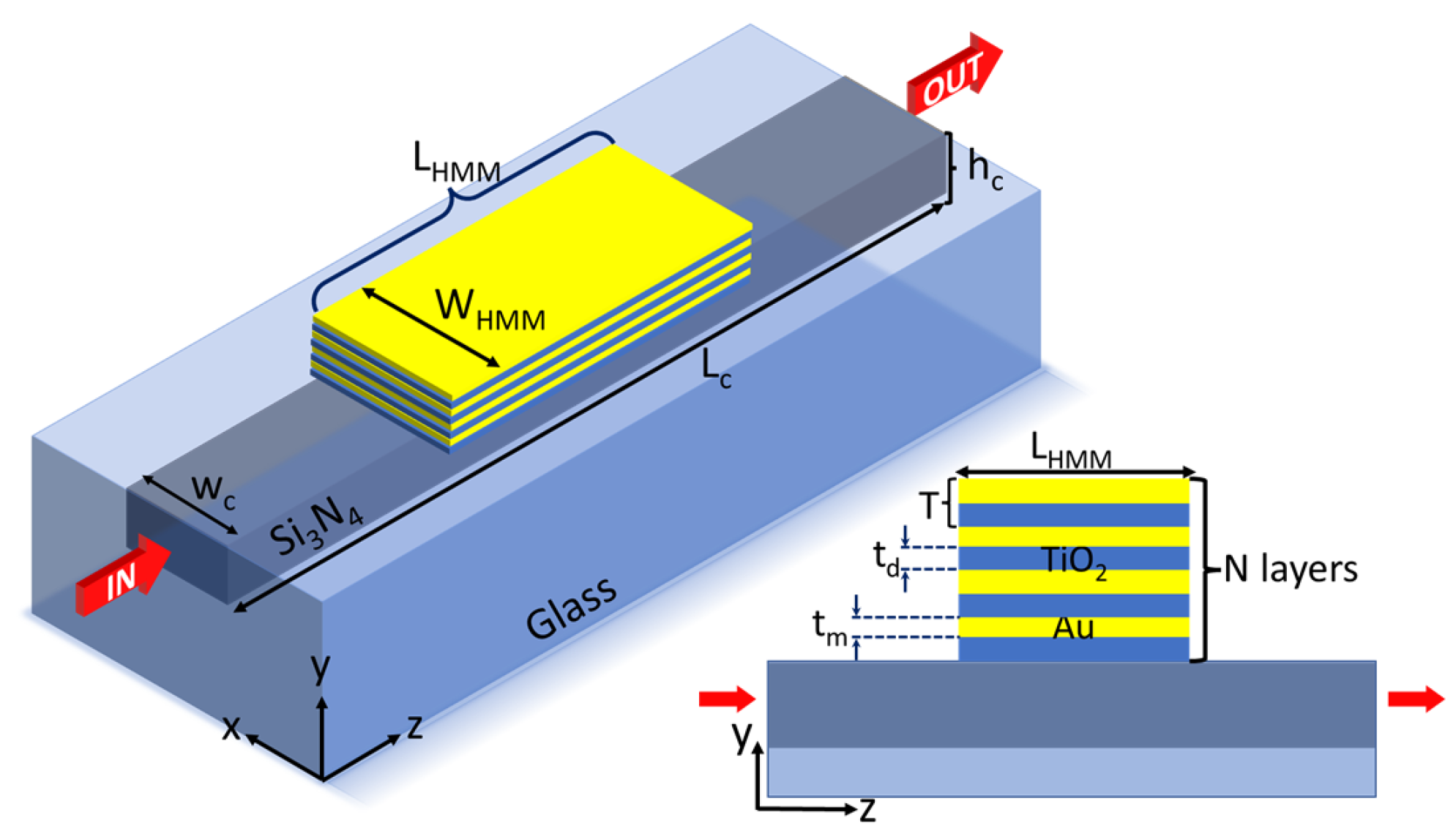

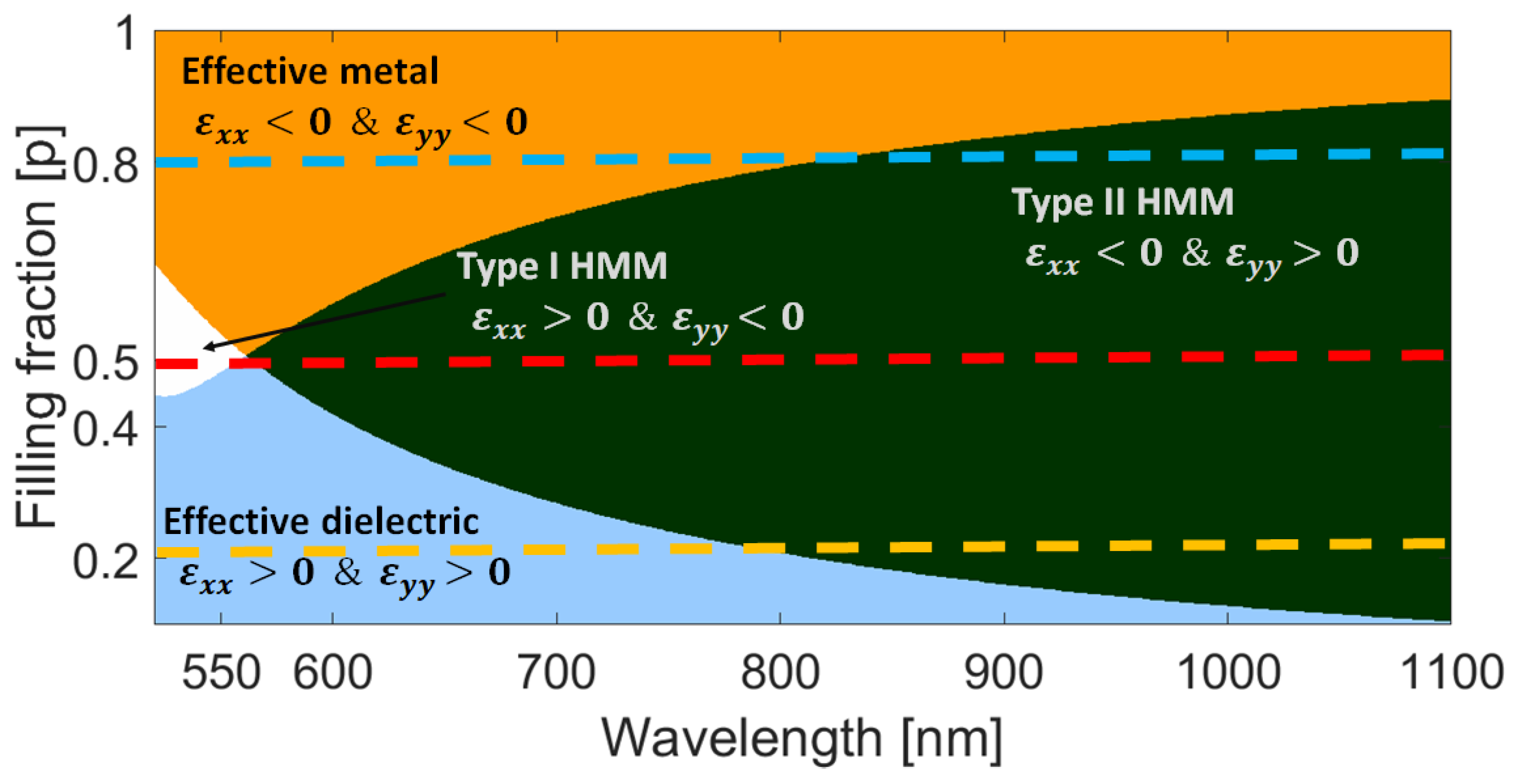
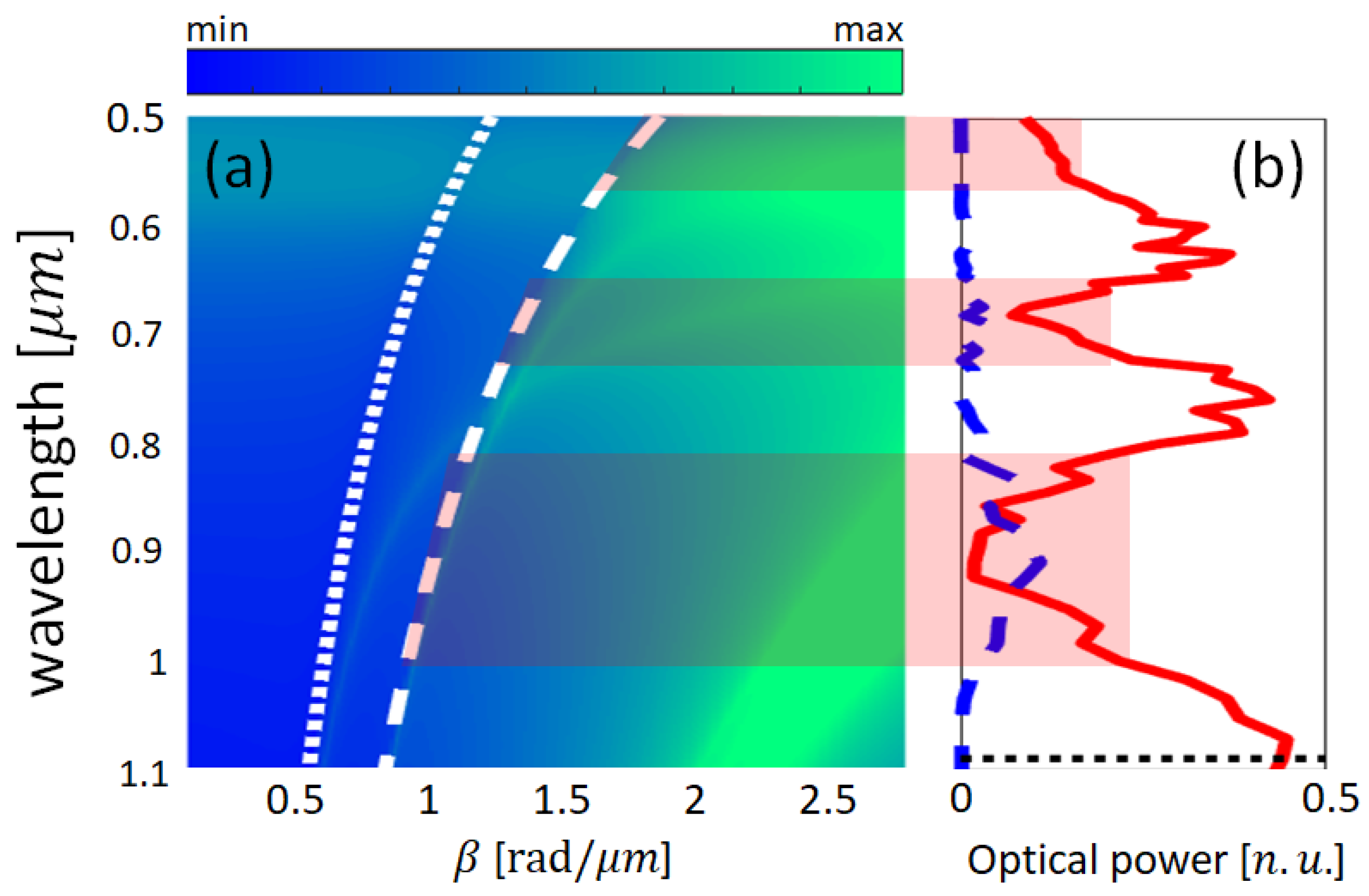
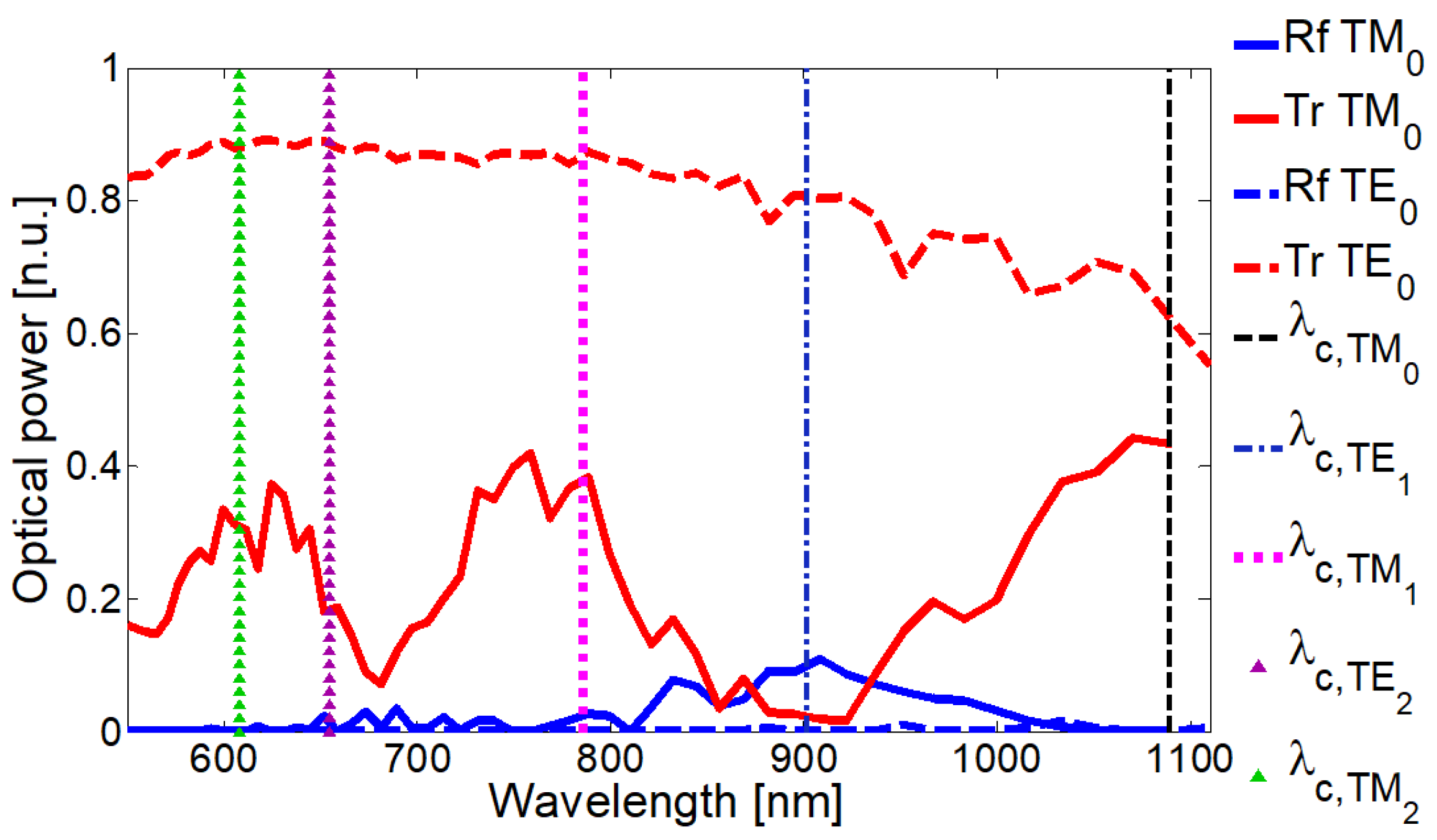

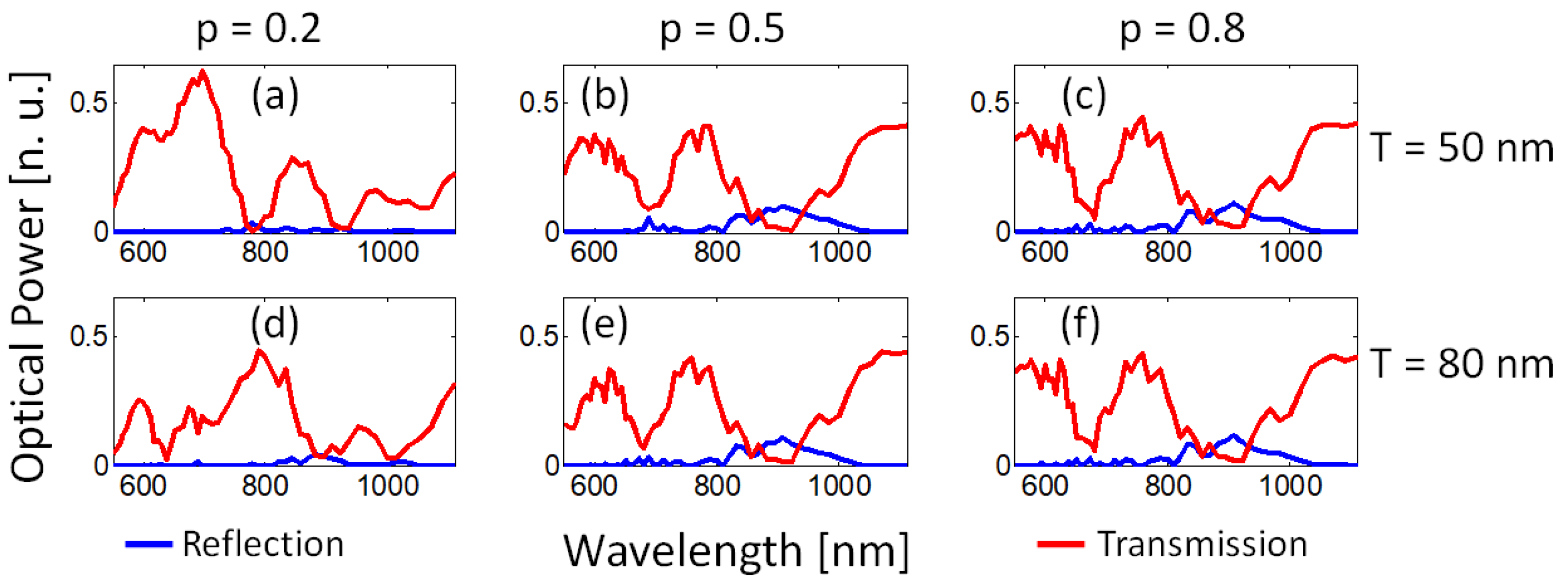
Disclaimer/Publisher’s Note: The statements, opinions and data contained in all publications are solely those of the individual author(s) and contributor(s) and not of MDPI and/or the editor(s). MDPI and/or the editor(s) disclaim responsibility for any injury to people or property resulting from any ideas, methods, instructions or products referred to in the content. |
© 2023 by the authors. Licensee MDPI, Basel, Switzerland. This article is an open access article distributed under the terms and conditions of the Creative Commons Attribution (CC BY) license (https://creativecommons.org/licenses/by/4.0/).
Share and Cite
Abdulkareem, M.-u.A.; López-Rayón, F.; Sosa-Sánchez, C.T.; Bautista González, R.E.; Arroyo Carrasco, M.L.; Peña-Gomar, M.; Coello, V.; Téllez-Limón, R. Integrated Optical Filters with Hyperbolic Metamaterials. Nanomaterials 2023, 13, 759. https://doi.org/10.3390/nano13040759
Abdulkareem M-uA, López-Rayón F, Sosa-Sánchez CT, Bautista González RE, Arroyo Carrasco ML, Peña-Gomar M, Coello V, Téllez-Limón R. Integrated Optical Filters with Hyperbolic Metamaterials. Nanomaterials. 2023; 13(4):759. https://doi.org/10.3390/nano13040759
Chicago/Turabian StyleAbdulkareem, Mas-ud A., Fernando López-Rayón, Citlalli T. Sosa-Sánchez, Ramsés E. Bautista González, Maximino L. Arroyo Carrasco, Marycarmen Peña-Gomar, Victor Coello, and Ricardo Téllez-Limón. 2023. "Integrated Optical Filters with Hyperbolic Metamaterials" Nanomaterials 13, no. 4: 759. https://doi.org/10.3390/nano13040759
APA StyleAbdulkareem, M.-u. A., López-Rayón, F., Sosa-Sánchez, C. T., Bautista González, R. E., Arroyo Carrasco, M. L., Peña-Gomar, M., Coello, V., & Téllez-Limón, R. (2023). Integrated Optical Filters with Hyperbolic Metamaterials. Nanomaterials, 13(4), 759. https://doi.org/10.3390/nano13040759






